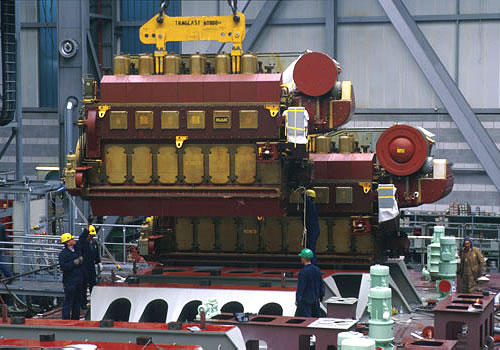
Caterpillar Poised to Reach IMO III Requirements for MaK Marine Engines
Pioneering today for a cleaner tomorrow.
As the global marine industry continues to evolve based on increasingly stringent regulations, Caterpillar Marine Power Systems has been focused on maximising research and development to satisfy requirements whilst minimising the impact on owning and operating costs. The introduction of IMO II regulations from the International Maritime Organization (IMO) on January 1, 2011, will reduce the levels of Nitrogen Oxides (NOx) by approximately 20% in comparison to the current IMO I regulations. With these regulations in mind, Caterpillar Motoren, the manufacturing arm that manages the production of MaK engines in Germany and China, has fully completed a strategy to release IMO II-compliant versions of the four MaK engine series.
However, the MaK engineers in Kiel, Germany, are already looking forward to the next major regulations milestone which will impact the marine industry – IMO III regulations. This new set of emission requirements will be enacted on January 1, 2016, for Emission Control Areas (ECAs) to further reduce NOx emissions from marine vessels. While most engine manufacturers are expecting to meet IMO II standards through combustion process optimization, reaching IMO III standards will typically require a great deal more engineering and development from the engine manufacturer.
MaK engineers are currently developing and testing a range of the following four solutions, which will be part of a “tool box” offered to customers to assist in meeting IMO III regulatory standards. While none of these solutions are fully developed at this time, engineers at Caterpillar Motoren believe that the final solution offering for customers to meet IMO III standards will be a package of one or more of these solutions, based on individual customer needs. Further testing will ensure full compliance with the IMO III standards without sacrificing performance levels on the MaK engines. The following key technologies depict some of the most prominent solutions that are being tested.
Exhaust Gas Recirculation (EGR)
EGR is an “on engine” technology which recycles part of the exhaust gas stream back to the air intake side after cooling and scrubbing. The technology reduces the NOx levels and may provide a path towards reaching IMO III required NOx levels. Testing by MaK engineers is currently on-going to ensure a suitable outcome. The advantage of EGR is the potential, together with other ‘on engine’ developments, to have an IMO III compliant engine without further after-treatment. In turn, the added technology increases the engine complexity, impacts fuel consumption and may include sensitivities to certain fuels with higher sulfur levels. Additionally, the EGR concept works hand in hand with other internal measures such as common rail fuel injection, series turbocharging and other carefully interwoven developments.
Selective Catalytic Reduction (SCR)
SCR is an aftertreatment technology which uses an additional agent (urea) to reduce NOx levels at least to IMO III levels. For customers operating both inside and outside of protected or controlled emission areas, the SCR option may be optimal, as the technology can be switched on and off as necessary to meet local regulations. Thus, the SCR solution promotes sustainability by limiting emission output as long as a certain temperature (typically around 320° C) is maintained to maximize the efficiency of the technology.
Scrubber
Scrubber is an aftertreatment technology to reduce sulfur levels in the engine exhaust when low sulfur diesel is not available. Various scrubber technologies exist, which extend to areas such as wet scrubbers, dry scrubbers and plasma technology, which can reduce fuel costs by allowing customers to purchase normal diesel fuel and reducing the sulfur levels, rather than purchasing the typically more expensive low sulfur fuel. While global sulfur limits vary, the limits are going down step wise over the next years so the need to reduce this emission will become quite important.
Dual Fuel
Dual Fuel is an engine technology that allows the engine to run on a combination of both diesel fuel and gas to reduce NOx, SOx and CO2. The current challenge for this strategy is the low global infrastructure established for gas distribution, the ongoing development of a regulatory framework, and the ongoing development of Marine Classification Society (MCS) approvals. However, there has been a clear increase in interest from the global marine industry into the dual fuel option, and Caterpillar Motoren has launched a New Product Introduction (NPI) project to develop a dual fuel
engine with a pilot launching in 2014. The dual fuel strategy has clear environmental commitment for customers.
For more information about MaK power solutions, visit your local MaK dealer or visit MARINE.CAT.COM.
# # #
About Caterpillar Marine Power Systems
Caterpillar Marine Power Systems, with headquarters in Hamburg, Germany, groups all the marketing and service activities for Cat and MaK marine engines within Caterpillar Inc. The organisation provides premier power solutions in the medium- and high-speed segments with outputs from 93 to 16,000 kW in main propulsion and 10 to 7,680 kWe in marine generator sets. The sales and service network includes more than 2,100 dealer locations world-wide dedicated to support customers in ocean-going, commercial marine and pleasure craft wherever they are.
More information is available at: MARINE.CAT.COM/pr
About Caterpillar
For more than 80 years, Caterpillar Inc. has been making progress possible and driving positive and sustainable change on every continent. With 2009 sales and revenues of $32.396 billion, Caterpillar is a technology leader and the world’s leading manufacturer of construction and mining equipment, clean diesel and natural gas engines and industrial gas turbines.
More information is available at www.cat.com.
We use cookies to improve your experience. By continuing to use our site, you accept our Cookies, Privacy Policy,Terms and Conditions. Close X